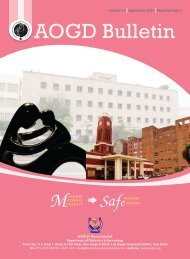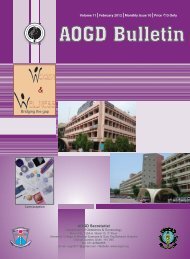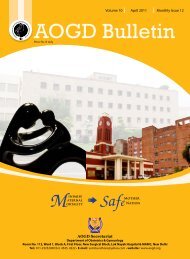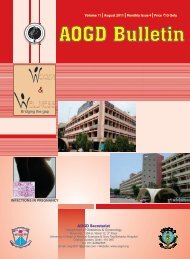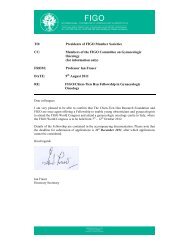July 2010 - AOGD
July 2010 - AOGD
July 2010 - AOGD
Create successful ePaper yourself
Turn your PDF publications into a flip-book with our unique Google optimized e-Paper software.
<strong>AOGD</strong> Bulletin <strong>AOGD</strong> Bulletin <strong>AOGD</strong> Bulletin <strong>AOGD</strong> Bulletin <strong>AOGD</strong> Bulletin <strong>AOGD</strong> Bulletin <strong>AOGD</strong> Bulletin <strong>AOGD</strong> Bull <strong>AOGD</strong> Bulletin<br />
Journal Scan<br />
Dr Shakun Tyagi, Dr Neha Singh, Dr Ayesha Arif, Dr Seema Beniwal<br />
WHAT MEASURED BLOOD LOSS TELLS US<br />
ABOUT POSTPARTUM BLEEDING: A SYSTEMATIC<br />
REVIEW. (BJOG <strong>2010</strong>;117:788–800) ___________<br />
Sloan NL, Durocher J, Aldrich T, Blum J, Winikoff B<br />
Objectives: Systematic review of measured postpartum<br />
blood loss with and without prophylactic uterotonics for<br />
prevention of postpartum hemorrhage (PPH).<br />
Methods: 29 studies with objective measurement of blood<br />
loss after delivery were evaluated. Most of the studies<br />
measured blood loss by placing a bedpan underneath the<br />
parturient woman. The collected blood was poured into a jar<br />
for volume measurement, and all soaked gauze pads were<br />
counted and weighed. A few studies used the fairly new<br />
blood collection sheet or delivery drape to calculate blood loss.<br />
Results: The distribution of average blood loss is similar<br />
with any prophylactic uterotonic, and is lower than without<br />
prophylaxis. Compared with no uterotonic, oxytocin and<br />
misoprostol have lower PPH (≥500 ml) and severe PPH<br />
(≥1000 ml) rates. Oxytocin has lower PPH and severe PPH<br />
rates than misoprostol.<br />
Conclusion: Oxytocin is superior to misoprostol in<br />
hospitals. Although oxytocin is superior, misoprostol<br />
substantially lowers PPH and severe PPH. A sound<br />
assessment of the relative merits of the two drugs is needed<br />
in rural areas, where most PPH deaths occur.<br />
RISK OF UTERINE RUPTURE ASSOCIATED WITH<br />
AN INTERDELIVERY INTERVAL BETWEEN 18 AND<br />
24 MONTHS (OBSTETRICS & GYNECOLOGY, MAY<br />
<strong>2010</strong>;115,( 5): 1003-6) _______________________<br />
Bujol E, Gauthier R<br />
Objective: To estimate the association between interdelivery<br />
interval and uterine rupture in women with a<br />
previous cesarean delivery<br />
Methods: Secondary analysis was performed in a<br />
retrospective cohort study of women who underwent a trial<br />
of labor after undergoing a previous cesarean delivery. Only<br />
singleton pregnancies with a trial of labor at term were<br />
included. The rates of uterine rupture were compared among<br />
women with interdelivery intervals 24 months or longer<br />
(controls), 18–24 months, and fewer than 18 months. The<br />
student t test and multivariable logistic regression analysis<br />
were conducted. A P value of less than .05 was considered<br />
significant.<br />
Results: Of the 1,768 women analyzed, 1,323 (74.8%)<br />
had an interdelivery interval of 24 months or longer, 257<br />
(14.5%) had an interval between 18 and 24 months, and 188<br />
(10.6%) had an interval of less than 18 months. The rate of<br />
successful VBAC (70%, 74%, and 73%, respectively; P=0.28)<br />
not different across the three groups. After adjustment for<br />
confounding variables, an interdelivery interval less than 18<br />
months was associated with a significant increase of uterine<br />
rupture (odds ratio [OR], 3.0; 95% confidence interval [CI],<br />
1.3–7.2), whereas an interdelivery interval between 18 and<br />
24 months was not (OR, 1.1; 95% CI, 0.4 –3.2)<br />
Conclusion: The risk of uterine rupture was significantly<br />
higher in women with an interdelivery interval less than 18<br />
months than in women with an interval of 24 months or<br />
longer, but not in women with an interval between 18 and<br />
23 months. An interdelivery interval less than 18 months<br />
was an independent and an important factor associated<br />
with uterine scar defect, after adjustment for a uterine<br />
scar thickness less than 2.3 mm and a previous single-layer<br />
closure of the uterus.<br />
PROGESTOGEN TREATMENT OPTIONS FOR<br />
EARLY ENDOMETRIAL CANCER (BR J OBSTET<br />
GYNAECOL <strong>2010</strong>;117:879–84) ________________<br />
Cade TJ, Quinn MA, Rome RM, Neeshama D<br />
Objective: Analysis of cancer-free outcome and fertility<br />
potential with progestogen therapy for early endometrial<br />
cancer.<br />
Methods: Sixteen patients receiving progestogen therapy<br />
for stage-1 grade-1 endometrial cancer were retrospectively<br />
reviewed and their response to treatment, duration of<br />
response and fertility outcome in a specialist gynaecological<br />
oncology unit at a tertiary hospital was evaluated.<br />
Results: Of the 16 patients, four received an oral<br />
progestogen, three received levonorgestrel-releasing<br />
intrauterine system (Mirena), and nine received both forms<br />
of treatment. Response to therapy was assessed by disease<br />
regression on serial endometrial curettage. Ten patients<br />
(63%) responded to treatment, with a median time to<br />
response of 5.5 months. Six patients did not respond, but<br />
they were either early in treatment or opted for surgical<br />
management before the average time of response. No<br />
patient who responded had a later recurrence. The mean<br />
follow-up time was 27 months (range 3–134 months),<br />
with no patient deaths. Three patients had successful<br />
pregnancies.<br />
11




